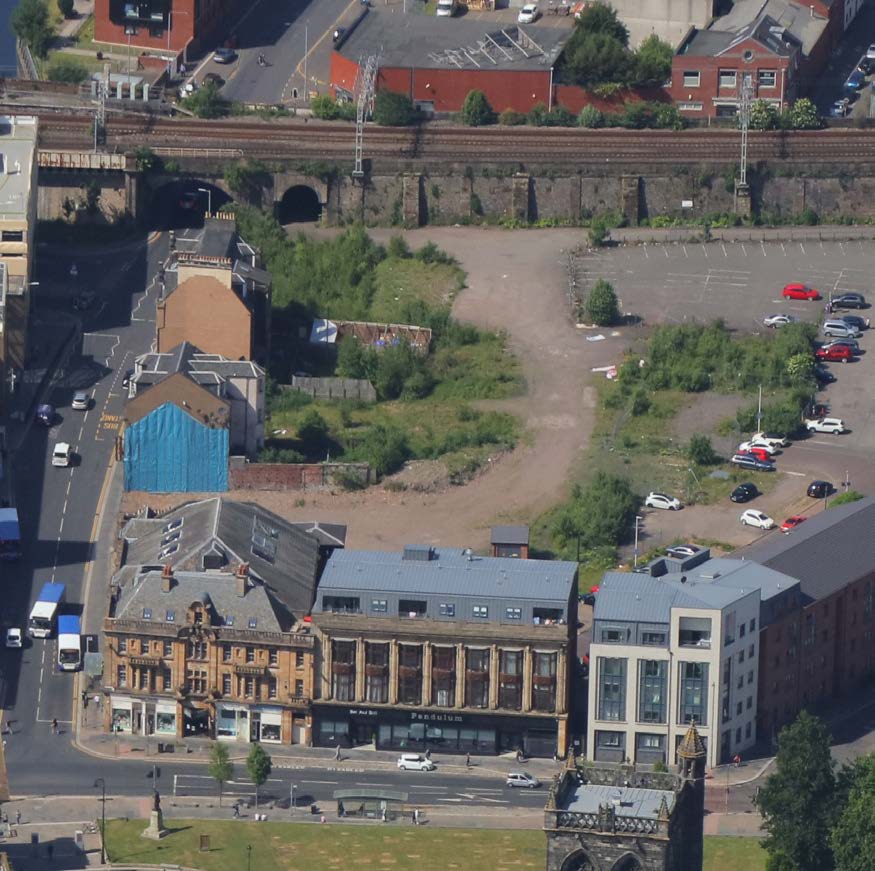As part of our work on Housing to 2040, we spoke to five people involved in recent affordable housing projects in Paisley and Dunbeg. Adrian Stewart is the Director at DO Architecture. Here he talks about Paisley’s dense urban environment and its impact on placemaking, consulting the neighbourhood, and a post-occupancy evaluation.
Abbey Quarter phase three is on the site of the former Arnott’s department store in Paisley. It is one of a number of new housing developments in the town intended to enhance the 24-hour residential presence in its urban centre. At the moment, the buildings are fully formed and in the process of being fitted out internally.
The project will deliver 26 new two-bedroom social rented homes, ten of which are designed with additional amenities to accommodate an elderly population, including a lift serving all stories.
Dense urban environment
The very dense urban environment, combined with a compact site on a busy commercial street, required us to make careful placemaking moves. Our initial aspiration was to create a façade that was appropriate for its high-profile civic location on Smithhills Street. It would also provide the ingredients for a good quality home, such as privacy and good quality internal and external spaces.
The approach we chose was to create a deep masonry screen that sits against the public pavement. This masonry screen then protects private outdoor balcony spaces serving each flat and provides a physical buffer zone between the public street and private home interior. Living spaces are located on the Smithhills Street side of the building where there is heavy bus traffic. Bedrooms are on the rear courtyard side, which is quiet and much more private.
The building is deliberately double-fronted with a common stairwell that opens to both the bustling Smithhills Street and the more private and quiet rear courtyard, where, alongside 100% resident parking, shared green spaces are provided. Green space provision was an explicit requirement the client brief and local plan, rear courtyard around which recent and future housing phases will gravitate.
Neighbourhood consultation
A consultation event took place during the planning application process, inviting comment from neighbouring properties, co-hosted by Link Housing Association and DO. It provided positive input to the developing design and ensured neighbours were fully abreast of the changes taking place next door and within their community.
One of the greatest challenges of this project was the physically compact nature of the site and its position between two existing buildings. The fact that one of these, the Methodist Central Hall, is listed and historic certainly made this quite a challenging project. The limited size of the building also placed financial pressure on the development, which would have been more financially viable with a greater density. But this was not permitted on this site.
Post-occupancy evaluation
We plan to establish a feedback loop in the form of a post-occupancy evaluation once the building is handed over and occupied, through the first year of occupation, and during the rectification period. This is a critical element of continually striving to improve the way new housing is made and the methods by which we make it.
We expect to hear both positive and negative critiques of these places for living. We acknowledge, as most architects do, that making buildings is an iterative process. It requires change and improvement and encourages us to learn from previous projects to make the next better.
Our take-away from this project is to ensure that we have a realistic understanding of the unique challenges when making new housing in a town centre context. Here restricted space and access, noise, and air pollution are factors. But these challenges sharpen our focus on the core requirements of making quality and affordable new homes for people in town centres.
Header image credit: Cooper Cromar, Do Architecture, Renfrewshire Council, Park Lane Developments (image credits from Housing to 2040 Paisley workshop report)
Housing to 2040
In 2019, the Scottish Government looked at what Scotland’s homes and communities should look and feel like in 2040, and the options and choices to get there. We supported the Housing to 2040 consultation with a series of workshops, interviews and a travelling exhibition.

